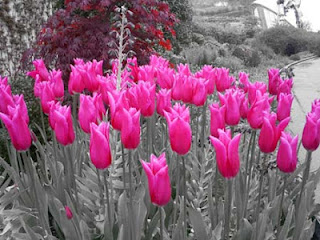This image is of the house at Lites - Carey Manor near Yeovil. Not a very sunny day - note the sky! What sky you might say? Well it is there but grey cloud covering the whole sky. We did get some good weather on this trip, so the first task was to find a photo with a decent blue sky with some interesting clouds if possible.
This shot of Glaston bury the following day looked very promising... So now I have a photo without a sky, and a photo of a sky. Will they match?
The following steps were taken to put the two together:-
- Select the sky in the first image with the magic wand (a single click since all the sky is the same colour). Now from the select menu choose INVERT.
- Copy the image except the sky and paste into a new image.
- Select a rectangle from the sky in the second image; copy this selection and paste as a new layer into the new image from the last step.
- Select the new layer and then choose from the edit menu, TRANSFORM. Select SCALE
- Expand the sky image until it fits behind the buildings without the background showing.
- I was not finished yet.
- First of all, for good measure, I flipped the image horizontally (Image/Rotate Image)
- I then wanted to make sure the chimney was vertical. So I rotated the image in one or two steps to achieve this.
- Now the roofline of the adjoining chapel was wrong.
- I selected the whole of the chapel with the magnetic lassoo tool. Again, using the transform function I rotated the chapel to achieve a horizonta roofline.
- This left gaps with the background showing thru around the chapel. These were filled in with the clone stamp tool.
Mmmm, I may have overcompensated for the angle of the chimney, but otherwise I have learnt a few tips and the image is considerably better. Don't you think?











